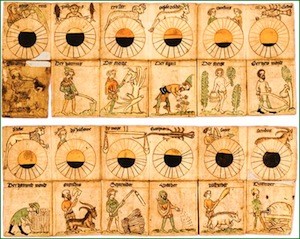
Session du 52e Congrès International sur les études médiévales (International Congress on Medieval Studies, 11-14 mai 2017, Kalamazoo, Western Michigan University).
This session proposes to investigate visual strategies used in time-reckoning and calendar constructions. Medieval illustrations of scientific works, computus treatises (including Bede’s De temporum ratione), historical chronicles, almanacs and moral and theological tracts, display a vast spectrum of images dealing with the natural and divine causes of time phenomena, their manifestations, their various effects on the world and their universal significations.
These images testify to a wide range of subjects and interests, from cosmological and astronomical explanations, to practical considerations regarding liturgy, astrology, medicine, divination, prognostication, to history and geography, to practical and speculative mathematics, and to symbolic devices working as visual exegesis of the creation.
Given the rich corpus of source material, how might the visualization of thime through schematization and volvelles help us understand the role of time in medieval life and culture? How did schemata and diagrams represent specific strategies of knowledge transmission through geometrical relationships, color systems, and numerical and spatial representations? Although modern medieval studies witness an increasing interest in schemata and diagrams, the omnipresence and diversity of visual reflexions on time in the Middle Ages contrasts with the small number of case studies dedicated to the subject.
This session welcomes papers focused on, but not limited to:
the visualization of relationships between time, space and matter;
the schematization of time in medical theory and practice;
the depiction of liturgical time;
the correlation between time-reckoning and celestial phenomena, either astronomical or astrological;
the calculation of past and future dates through images concerning chronology and eschatology.
The panel features 15-20 minutes papers. Please send an abstract (150 to 350 words), a short CV and completed Participant Information Form to Arthur Hénaff (arthur.henaff@etu.ephe.fr) and Sarah Griffin (sarah.griffin@kellogg.ox.ac.uk) by September 15, 2016.
Contact Info:
Arthur Hénaff, École Pratique des Hautes Études (arthur.henaff@etu.ephe.fr)
Sarah Griffin, University of Oxford (sarah.griffin@kellogg.ox.ac.uk)
http://wmich.edu/medievalcongress/submissions
Formulaire de participation en PDF

Leave a Reply
You must be logged in to post a comment.